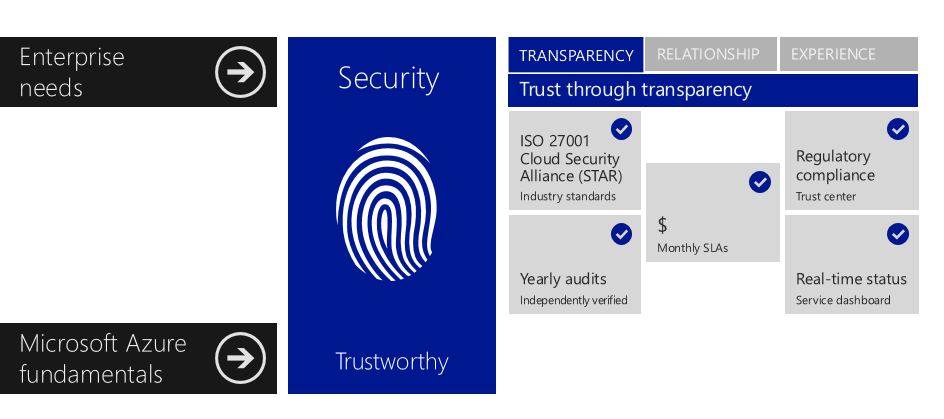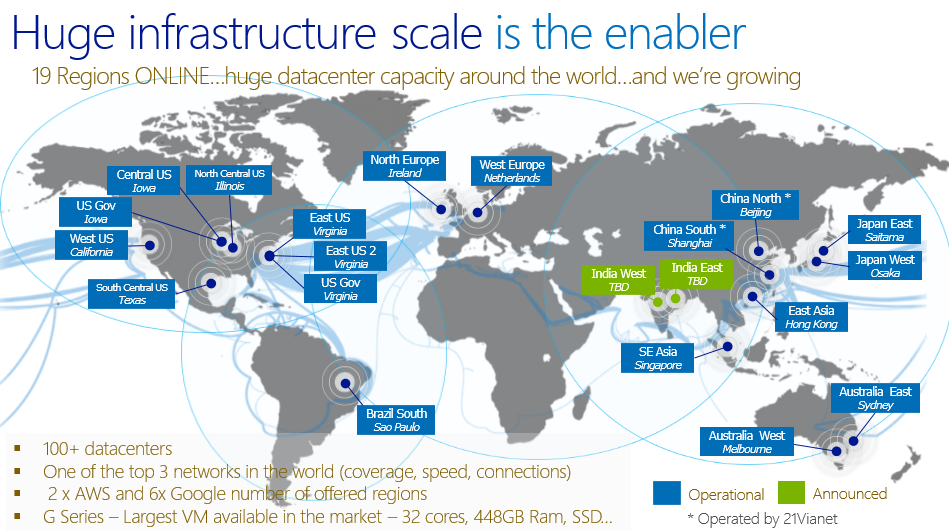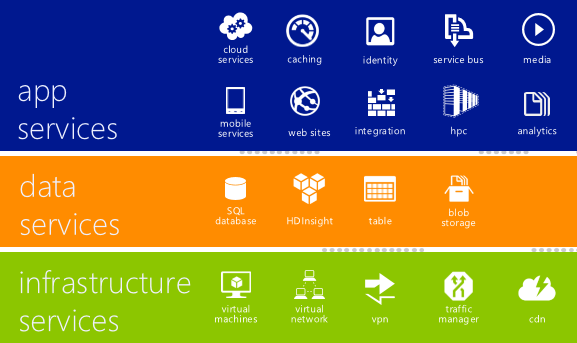Cloud!! Cloud!!! Cloud!!! Everywhere!! Public-cloud, private-cloud, hybrid-cloud are the most common words you hear in IT these days. There are mainly two types of organizations in cloud service business. One type provide tools, techniques to build your own cloud or help organizations to become cloud service providers. Others bring their own products or services to the cloud and then let customers to use it from there. Microsoft stand strong in cloud because it do both of above.
“Microsoft Azure”, I am sure everyone in IT heard about this already, this post is not just about azure but it’s about why your enterprise should move in to “Azure – The Cloud”.
There are mainly 3 facts people consider when moving in to public cloud.
Speed – if you going to put a new server in to your organization how many days, steps it will take? You need to search for model, check stock, arrange shipments, custom clearance, rack mount and install software etc. so we talking about days to weeks. But in a cloud it is matter of seconds to get a server instance or service up and running. Time is crucial for any business, for ex- if you running software firm and if your developers need to wait a week to get new server setup for testing purposes of an application definitely it affect the project delivery time.
Scale – Cloud will give you almost infinite computing resources. So you can easily increases or decreases the allocated resources for your application or services according to the business requirements. If it’s in datacenter environment you may need to involve with lengthy migrate cycles, downtimes to match resources with application needs.
Economics – If you leased a rack in datacenter if you used it fully or not you need to pay for it, power and bandwidth also same, use or not you need to pay. But in cloud you pay only for the things you “used”
But NOT YET???
Even organizations urge to move to cloud there are few facts which holding them back by making the move.
If it’s not a new business, organizations already spent $$$$ building their current infrastructure. It may include data center facilities, servers, software licenses, man hours etc. so can it just through away? Because of this reason most of organizations are end up with hybrid-cloud setup. According to latest IDC findings 40% of enterprises already adopting to hybrid-cloud. but question is even go for hybrid-cloud how easily services and resources can integrate together with minimal impact.
One of another concern is the complexity of IT needs. Your organization may be running with lot of different frame works, software services, development languages, tools etc. so before move into cloud it is important to make sure the cloud you choose can handle this complex requirements.
Security, it’s not only about the company data security in the cloud, if organizations bringing their application or services to the cloud they need to make sure its customers can trust the security in place.
Why Microsoft Azure?
Microsoft Azure already addressed these 3 main concerns. Let’s dig deep to see how they did it.
On-premises AND Cloud: We believe in a world where you’re integrating public cloud with your on-premises infrastructure, and using each where it makes sense, in conjunction with each other. Think and, not or. It’s not an on-premises OR cloud proposition – it’s an AND proposition. And when they say integration, they mean true integration – across infrastructure, apps, identity, and databases. This is what we call hybrid.
Microsoft is the only company which has the necessary assets across virtualization, identity, data platform , development and management to provide a consistent experiences across on-premises, our cloud and 3rd party service providers. This vision and strategy – called “Cloud OS” – is what Microsoft aim to deliver for our customers. If you choose look at other Cloud vendors that provide public OR private cloud offerings (Amazon, VMware, or Google), you have to cobble together disparate offerings and you will not get a seamless experience.
Open, Broad and flexible: Microsoft realize that you’ll want to run a variety of workloads in the cloud. In Windows Azure, we will of course provide first and best experience and support for Microsoft workloads, but at the same time we have embraced other open technologies so you get a cloud experience that satisfies your heterogeneous needs.
In enterprises, Java and .NET are still most used, but developers are also using PHP, Python and other languages in addition. Windows Azure supports all these languages and more.
Windows Azure provides out-of-the box experience for open frameworks like Hadoop, web frameworks like WordPress, Joomla and Drupal. Microsoft also provide first party SDKs for developing apps using Android, IOS or Windows phones.
Microsoft not only support, but have embraced open technologies.
Microsoft also provide a broad set of services that provide you a good choice. In addition to the breadth of the platform, it’s important to note that using Windows Azure is not an all or nothing proposition. You can use most services independently of each other. For example, you can just use storage without compute or use DB without using storage. What you want to use and how you want to use is really YOUR choice.
Microsoft believe in Trust through Transparency. Microsoft are transparent in the following ways:
1. Microsoft participate in industry standards like ISO 27001, SSAE16 and Cloud Security Alliance.
2. Microsoft undertake yearly audits with independent 3rd parties
3. Microsoft provide a rich set of financially backed monthly SLAs (this differentiates us from other cloud providers like AMZN whose SLAs are fewer and annual). Monthly SLAs are more stringent with less room for error than yealy SLAs
4. All of Microsoft’s regulatory compliance and privacy policies are clearly explained in the online portal called Trust Center
5. Microsoft provide real time status of all the services via a Service Dashboard. We provide Root Cause Analyses in case of issues.
With Microsoft and Windows Azure, you’re relying on you existing relationship and account team to procure and get support.
1. Azure can be a part of you existing Enterprise Agreement you have in place with Microsoft. This way, you don’t have to negotiate and sign up for yet another agreement with another vendor.
2. Microsoft support Azure and other Microsoft software that you use just the same way. When you run Microsoft workloads on other cloud platforms, you might not get the same level of support. You’ll be relying on a single point of support for you infrastructure and software with Microsoft and Windows Azure
3. Microsoft have an Azure practice in MCS, and continue to be your trusted advisors as you start your journey with the Cloud.
Windows Azure is not Microsoft’s first foray into Cloud Computing. Microsoft have been doing this for more than two decades, and have the deepest experience in the industry.
Microsoft’s first datacenter was in 1989. Since then, Microsoft have run some of the largest global services securely and efficiently – Bing, Office 365 and Hotmail just to name a few.
Today, Microsoft run over 200+ global services 24×7 and here are some stats to show you how large scale and global our operations are.
Windows Azure is operated in the same manner by the same teams as some of these other global services. You can rest assure that security and operational efficiency is at our core.
Huge Infrastructure
Over the last few years Microsoft truly delivered a huge infrastructure to enable us to grow services at scale around the globe. Whether it’s Microsoft flagship facilities in Quincy, Washington or Boydton, Virginia, or some of the newly announced facilities in Shanghai, Australia and Brazil, it really is key for Microsoft to make smart investments around the world to deliver services in a resilient and reliable fashion.
A lot of people ask, what goes into site selection at Microsoft and how do Microsoft decide where to place our datacenter investments? There are over thirty-five factors in Microsoft site selection criteria. But really, the top elements are around proximity to customers and energy and fiber infrastructure, insuring that Microsoft have the capacity and the growth platforms to be able to grow Microsoft’s services.
Another key element is about skilled workforce. Microsoft have the right people to run and operate datacenters on a day to day basis.
We can categorize azure cloud building blocks in to 2 classes
Infrastructure services which are lower level building blocks
Data services that provide storage and data management capabilities to apps, and
App services which provide different capabilities to rapidly develop apps, scale and run apps at a global scale.
How to Start?
Azure provides 1 month free trial to start with and you can sign up using http://azure.microsoft.com/en-us/pricing/free-trial/
If you looking for pricing you can use this great tool http://azure.microsoft.com/en-us/pricing/calculator/
See ya in the cloud!!!
Note – This article is dedicated for Joel Langford from MVP Award Program – Canada, A nice, talented guy. He passed away on 3rd June 2015. Just two days ago he suggested to write an article about this topic for mvp blog. My prayers with him and his family! Rest in peace mate!











